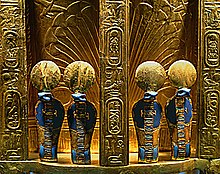Uraeus
The Uraeus (/jʊəˈriːəs/)[1] or Ouraeus (Ancient Greek: Οὐραῖος, Greek pronunciation: [οὐραῖος] ⓘ; Egyptian: jꜥrt, "rearing cobra", plural: Uraei) is the stylized, upright form of an Egyptian cobra, used as a symbol of sovereignty, royalty, deity and divine authority in ancient Egypt.
[2] Later, the pharaohs were seen as a manifestation of the sun god Ra, and so it also was believed that the Uraeus protected them by spitting fire on their enemies from the fiery eye of the goddess.
In 1919, after only a half-hour of excavation, the Qufti worker Hosni Ibrahim held in his hands the solid-gold Golden Uraeus of Senusret II.
The start in the rock-cut offering chamber, leading from the tomb, on the south, immediately revealed in the turnover of the six inches of debris, the Golden Uraeus crown ornament.
To mount it on the pharaoh's crown, two loops in the rear-supporting tail of the cobra provide the attachment points.
Additionally, the smaller scale king usually wore the Blue Crown when depicted in a protective group of deities.
[10] The angelic seraphim, found in the Hebrew Bible and later Jewish, Christian, and Islamic traditions, are frequently associated with serpents and are thought to have derived from the concept of uraeus.






